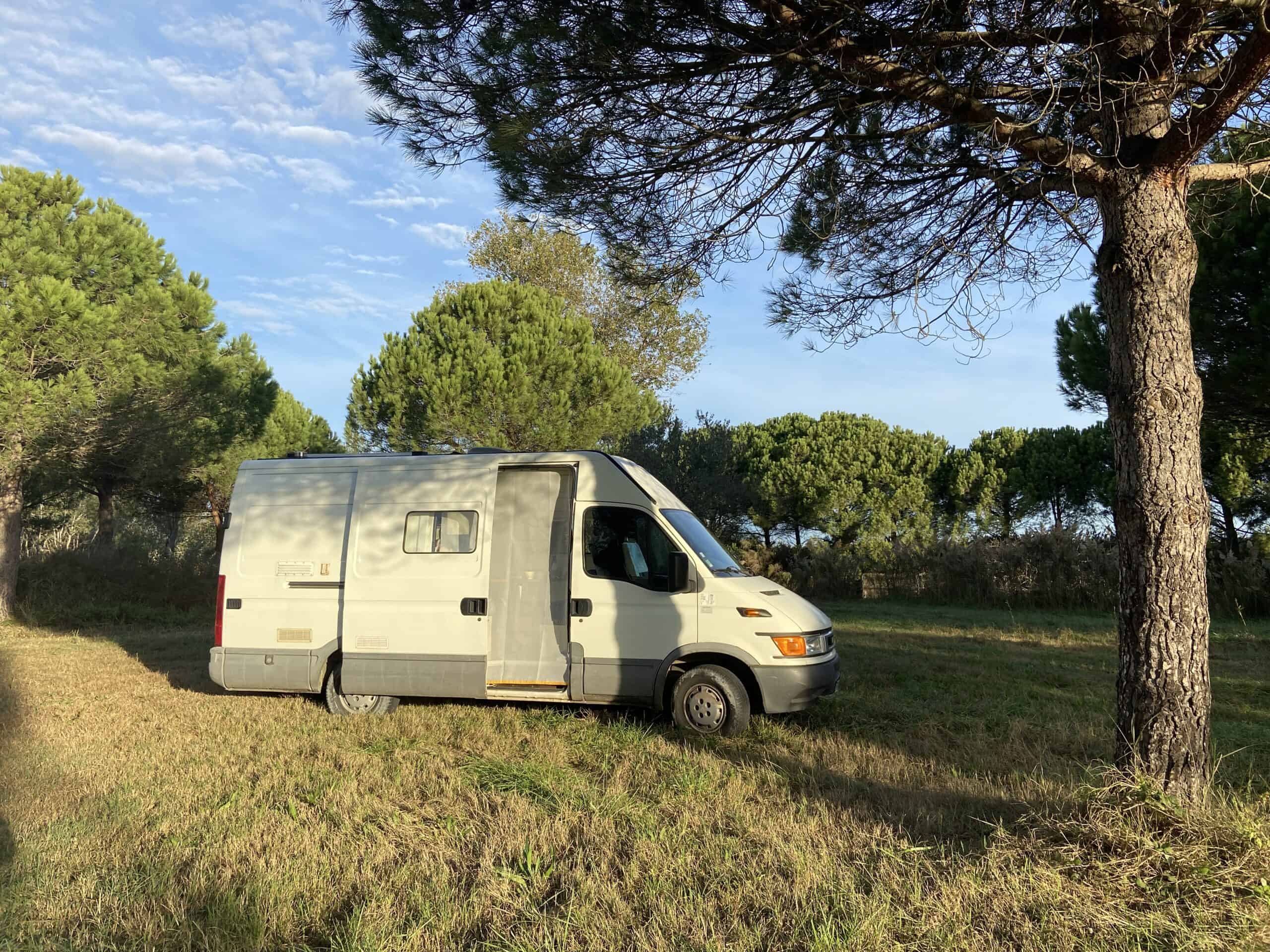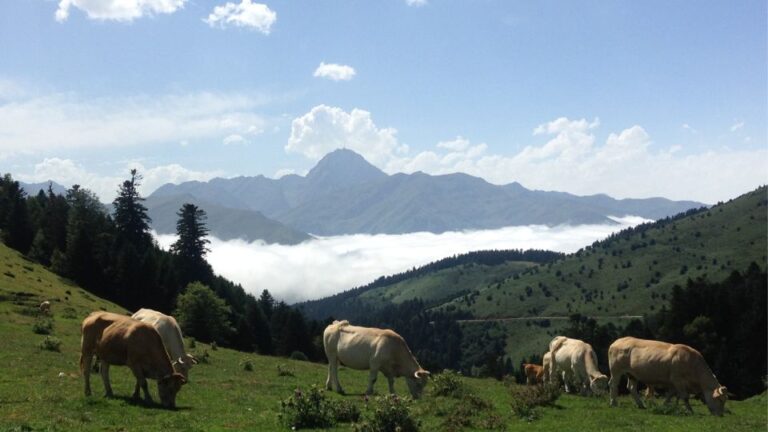How to store food in a van?
Ok, so we decided to spend months on the road and that meant packing the van. Given that we were staying in France we didn’t need to load the van with food for six months because we can shop here and there for what we need. Still, if there is one thing you need to know about storing food in a van, it’s that there is limited space.
The more you can utilize flexible storage and maximize vertical space, the better. Also, the more you pack fresh food together, the faster it goes bad because there is no air circulation. This week’s article outlines our van food storage and some of the things I’ve learned along the way.
What kind of storage do we have and how effective is it?
We have a long cupboard above the sink and cooktop and another, larger cupboard underneath. The upper cupboard has a door that flips up but doesn’t stay up. That means that you have to physically hold the door up and rummage around in the cupboard to find stuff with your other hand. That’s a pain.
When one of us starts cursing loudly, the other offers a helping hand and holds the door up. I admit it would help if it stayed up. There is also no light in the cupboard so if it’s dark, you need to hold a flashlight or wear a headlamp or you may very well grab a bag of rice when you want the coffee. I know, tragic, right?

The other issue many van owners experience is that in order to get at the box of pasta tucked right at the back of the cupboard, you have to remove the paper towel roll, the coffee, the rice, the box of tea, the bread and the tin foil. Then you have to put everything back in. Once you use the pasta, you have to do everything in reverse order. Why? Because if you actually want to cook, you need to clear the space where you dropped everything in order to get at the pasta.
This means a simple meal of pasta with pesto that takes ten minutes to prepare at home, takes 30 minutes in the van with all the moving about of stuff.
Clearly, cultivating patience while living in our van is an ongoing process and not always successful.
What do you store in the upper cupboard?
Because the cupboard is situated directly above the cooktop, it means that steam and heat from the cooktop can penetrate through the cracks into the cupboard.
As a result, we only store dry goods in it. That includes tea, coffee, pasta, rice, sugarcubes, plastic wrap, chips and nuts, instant mashed potatoes, granola, tea towels, the foldable camp toaster, and my crackers. We also store our bread bag in the cupboard which, now that I think of it, might be better stored in the lower cupboard.
What do you store in the lower cupboard?
The lower cupboard consists of three sections. The upper shelf, lower shelf and the space between the lower shelf and the door.


The upper shelf
The shallow, upper shelf has a tiny lip so stuff doesn’t slide off it. We have three plastic baskets on it. One holds plastic plates, bowls, Duralex glasses and two enamelled metal mugs sent to me from Australia. Next to that is a basket with a plastic salad bowl, a strainer and inside that we store bananas, tomatoes, avocados and other fresh fruit.
In front of the bowls are a jar of choucroute garnis and our tiny French press. The other low sided basket holds canned goods like sardines, tuna, pesto, tomato sauce, tinned mushrooms, coconut milk and beans. We can’t put much in that basket because the pipes from the sink hang above it. There is a little space between two baskets and we shove a jar of honey and sometimes an additional can of pesto or something.
The bottom shelf


On the shelf below we store our pressure cooker, fry pan, and three pots as well as an old beer box that holds too many plastic containers with lids. Every time my husband looks at it he repeats the same complaint. “Why do we have so many !@*ing useless boxes?!” He then shoves the box back in with a dramatic huff and slams the door shut.
I may actually just slowly ditch one box at a time when he’s not looking and one day there wouldn’t be any left and then, of course, he’d say, “ Where are the boxes? I need one!”
The space between the lower shelf and the door holds three, five litre jugs of water, and our bottles of olive oil, vinegar, and extra bottles of wine, beer, pastis and water.
Finally, shoved into nooks and crannies are three organic cotton net bags that hold onions, garlic and shallots, fruit in another one and sometimes carrots or other veggies in the other one.There is also usually a sack of potatoes somewhere, and inevitably, one or more come tumbling out of the cupboard onto the floor when we open the cupboard.
What storage containers are best for a camper van?
If you like camping in the wild, you know that every ounce of weight is important. It’s the same in the van. The overall weight of the van plays an important role in fuel economy so every addition, including what might seem a minimal impact like a plastic container, can and does contribute to the overall fuel economy of the van. Who knew?
Rigid plastic storage containers
One day I had the brilliant idea of buying tall sided plastic containers that would use the vertical space of the cupboards to their maximum. They would hold rice, pasta, lentils, beans and coffee. That would mean that the items would be safe and grains of rice or pasta wouldn’t fall down between cracks and start a fire on the leisure battery. The reasoning is sound and I thought my contribution to my husband’s van was innovative and highly practical. I thought.
My husband’s default response, ( or is it a French trait?), is to utter an emphatic “NON!” to pretty much any new suggestion I make for improvements. That is followed by a longwinded explanation of how long he’s owned the van, how many other people have made well-meaning but ignorant suggestions that just don’t work at all.
My ego gets its back up pretty much right away when I hear the inevitable “Non!” but I do try to bite my tongue and give him the benefit of the doubt. In this case, he made his case.
Once the rigid plastic containers are empty, they still take up a lot of space. Oh. Right.
I hadn’t thought of that. My thought was, well, if they’re empty, we just need to refill them, right? Apparently not. They weigh a lot and there is no flexibility; don’t even think about glass storage jars! They weigh a ton, rattle and vibrate and they break.
What are the best food storage options for a camper van?
Simply said, it’s the humble ziplock bag. You pour rice, pasta, granola, what have you, into the bag, then recycle the boxes or use them as garbage storage. Squish the air out, seal the bag and then shove them into nooks and crannies wherever you can find space. Ta da. The trick is to make sure the bag seals well or you will have a mess on your hands, so don’t cheap out on crappy ones.
I have seen that you can actually buy silicone ziplock bags and collapsible silicone containers but haven’t tested them out. I am not sure that they squish down and roll up like the traditional bags do but I may buy some and test them out. For now, I use Ziplock freezer bags because they’re thick and sturdy.
You can wash the bags out, use them again or even use them as garbage bags in a pinch. I hate throwing vegetable scraps into the garbage too. Putting all your veggie scraps into a ziplock bag avoids odors in the van, but then you can find a discreet place to throw them into nature to decompose naturally.
The other option is to buy collapsible storage containers but I’ve yet to try them and wonder whether the cost/benefit ratio is really worth it. We seem to manage ok with what we’ve got right now.
Where do you store fresh foods?

We have a tiny fridge that, once it’s packed, can feed us for up to a week. It has a teensy freezer section that holds about six ice cubes and a pint of ice cream. The door holds butter, my probiotics, a tube of tomato concentrate and underneath it a bottle of water, wine, milk, soy sauce, maple syrup and tabasco sauce.
There is one main shelf, a space under it and a tiny shelf next to the freezer compartment. At any given time we may have four pots of yogurt, a jar of jam, a jar of pickles, a small jar of mustard, endives, packages of smoked mackerel, smoked trout, sliced ham, bacon, a carton is six eggs, a small pot of creme fraiche, several different kinds of cheese, half an avocado, and a container of mushrooms.
And that, my friends, is about it. I usually let my husband manage the food storage and he gets highly frustrated by anything that isn’t correctly stored. It’s just easier to let him put the food away, take it out and then leave me to cook dinner.
We do not store food in any other locations except, perhaps for wine or water bottles that we sometimes put under the bunk beds where we store our boots and outdoor table and chairs. Ok, sometimes I have a secret bar of chocolate in my art supply bag, but now that he reads my blog, he knows it’s there too. Whatever. He’s not much of a chocolate eater and frankly, I forget it’s there. Ahem. Most of the time.
What would you change in the van if you could?
In the future, if I ever had another van, I’d likely have a better fridge, and would change the pots and pans for ones that nested together with removable handles. I would love to have a little oven of some kind so I could bake bread and cakes but really, when you live in France, you’re never far away from a bakery.
Soon, we will be heading into Spain, where it will be a whole other challenge for stocking our larder so stay tuned for the next stage.
If you’ve ever travelled, hiked, or what have you, I’d love to know what you’d done to maximize storage. Let me know in the comments section below.
Bisous,
Dana





